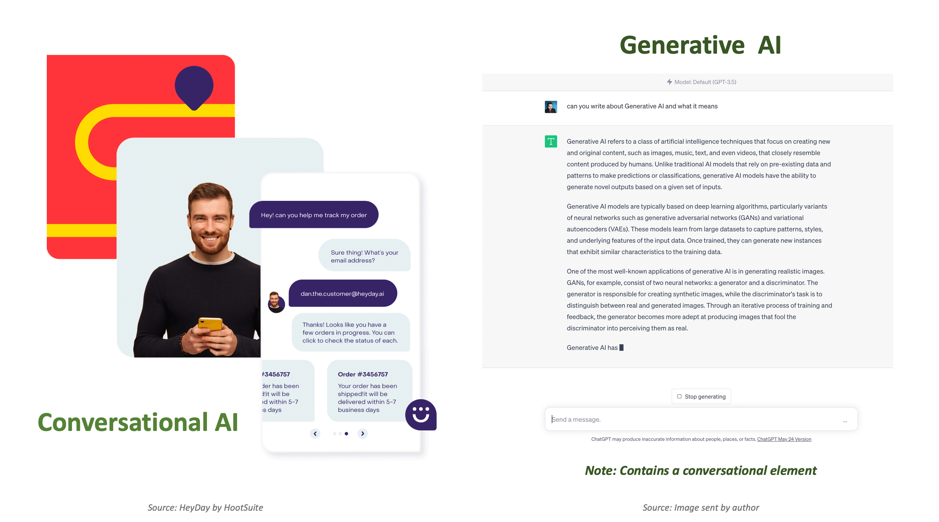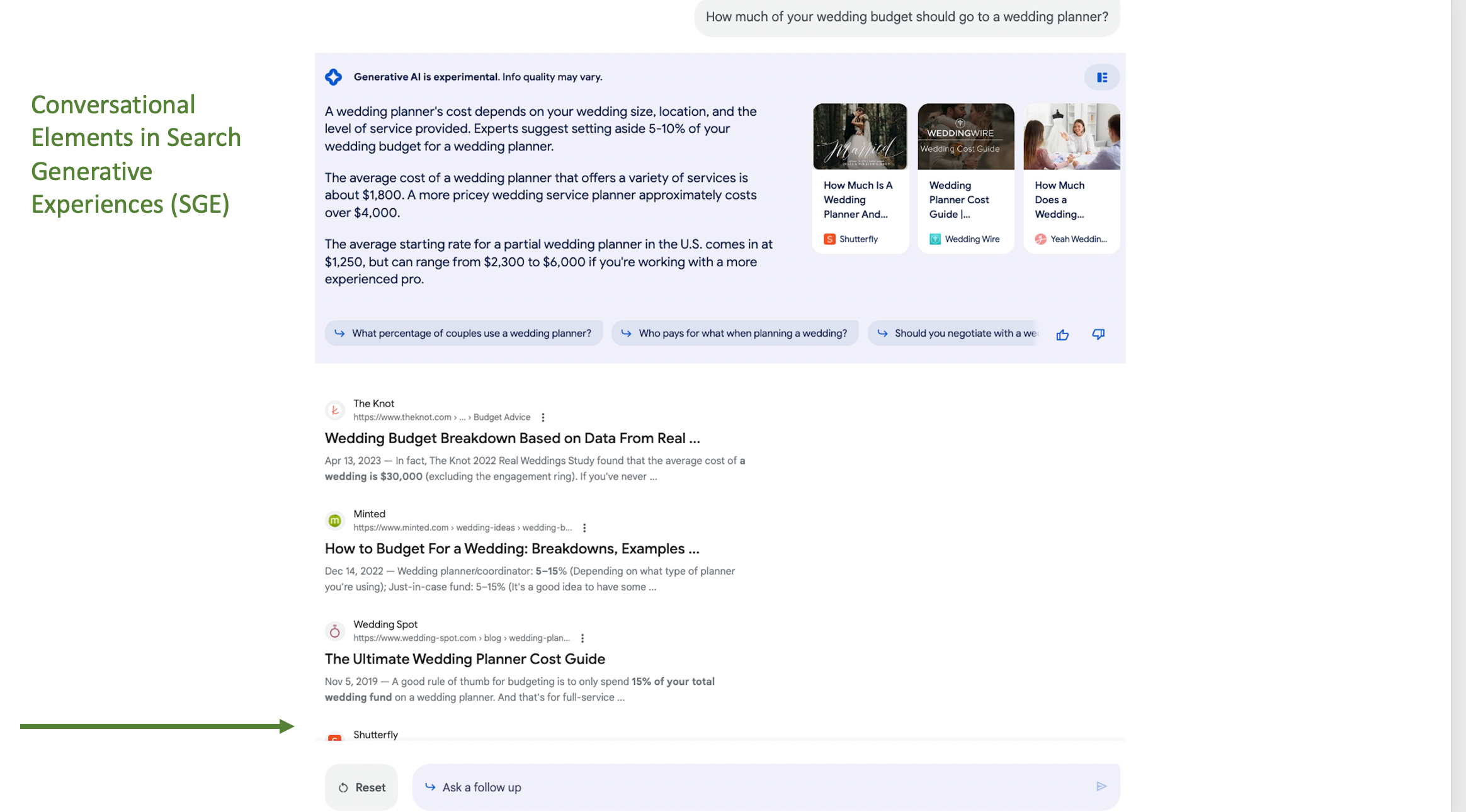Es posible que se sorprenda al saber que la inteligencia conversacional y la IA existen desde hace muchos años.
Desde la introducción de Facebook (ahora Meta) de Messenger en 2016 hasta la evolución de las tecnologías de voz como Alexa y Siri, está arraigado en nuestra vida cotidiana.
El reciente crecimiento de las aplicaciones basadas en chat y la integración de la IA generativa y conversacional en motores de búsqueda como Bing y Google ha alimentado el interés y la importancia de la inteligencia conversacional.
¿Qué es la inteligencia conversacional?
En su forma de marketing más simple, la inteligencia conversacional es la habilidad de comunicarse con confianza para lograr resultados exitosos. Implica una variedad de habilidades, como la escucha activa, la empatía, la adaptabilidad, la expresión clara y la creación de una buena relación.
Esta amplia gama de habilidades contribuye a conversaciones efectivas al comprender la dinámica de la comunicación humana.
¿Dónde encaja: IA conversacional, inteligencia y búsqueda?
La inteligencia artificial (IA) ha impulsado un cambio significativo en los últimos años con la aparición de chatbots y asistentes de voz.
En consecuencia, las estrategias de marketing de búsqueda han evolucionado para reflejar este cambio a través de la inteligencia conversacional, la búsqueda y el SEO.
En el marketing de búsqueda, la inteligencia conversacional se basa en información basada en datos y la integración de inteligencia artificial y aprendizaje automático con el objetivo de mejorar las interacciones y experiencias de los usuarios.
Los conocimientos se pueden utilizar para comprender la intención del consumidor y detectar patrones y tendencias críticos. Una vez más, la IA ayuda, ya que utiliza el procesamiento del lenguaje natural para comprender e interpretar mejor el lenguaje humano de manera conversacional.
Matices tradicionales entre la IA conversacional y la generativa
Si bien la IA generativa contiene cada vez más elementos conversacionales, la IA conversacional y la IA generativa difieren ligeramente en sus objetivos principales:
- La IA conversacional se centra en comprender y reaccionar al lenguaje humanomientras que la IA generativa tiene como objetivo autoproducir contenido.
- La IA conversacional imita la conversación humana mediante el procesamiento de entradas de lenguaje natural y produciendo respuestas similares. Por otro lado, la IA generativa crea contenido nuevo mediante el procesamiento de datos o entradas para generar salidas originales.
La IA generativa se diferencia de la IA conversacional al tener la capacidad de crear diversas formas de contenido más allá de la simple comprensión y respuesta al lenguaje humano.
 Imagen creada por el autor, junio de 2023
Imagen creada por el autor, junio de 2023- La IA conversacional exige una gran cantidad de datos de entrenamiento para lograr respuestas precisas al lenguaje humano. Mientras tanto, la IA generativa también necesita datos, pero su enfoque es el análisis de patrones en lugar de la comprensión del lenguaje.
- La utilización de la IA conversacional abarca diferentes aplicaciones, incluido el servicio al cliente, la traducción de idiomas y los asistentes personales. Sin embargo, la IA generativa se utiliza predominantemente en la investigación y la producción de contenido automatizado. Esto puede incluir diferentes formatos (imágenes, video, generación de código, correo electrónico, producción de redes sociales, etc.)
Leer más sobre SEJ: Nuevas funciones de IA generativa para Google Ads, Product Studio y más
Inteligencia conversacional y SEO
El SEO conversacional tiene como objetivo optimizar el contenido del sitio web para responder las preguntas de lenguaje natural utilizadas en las interacciones de búsqueda por voz y chatbot.
Se trata de mejorar el contenido de su sitio web en un tono conversacional para abordar de manera efectiva las consultas planteadas por los asistentes digitales. El SEO conversacional se enfoca en consultas más naturales y similares a las humanas que las búsquedas tradicionales basadas en palabras clave.
Read More On SEJ: Google Launches Bard AI Chatbot To Compete With ChatGPT
In AI, a chatbot or assistant generates helpful content and delivers accurate and efficient assistance by answering users’ questions, providing suggestions, or assisting with tasks beneficially.
This can entail:
- Providing specific information.
- Guiding users through complex processes.
- Navigating complex, intricate software.
Conversational intelligence and content intelligence are vital to enhancing your website and how content is found and optimized.
Analyzing large amounts of data to unearth insightful trends and patterns gives marketers valuable insights into the interests, intent, trends, and popular conversational phrases relevant to your target audience.
By providing real-time data and user behavior insights, you can analyze competitive strategies and optimize your site content.
It also helps you improve audience understanding and adapt marketing campaigns to enhance your website’s visibility, engagement, and conversion rates.
Utilizing its insights also allows you to make data-driven decisions about what to publish on your website.
In addition, the insights you gain give you a competitive edge as you can optimize your content for improved visibility and the evolving search landscape.
Utilizing Conversational Intelligence And The Convergence With Generative AI
The Introduction of Google’s Search Generative Experiences (SGE) is changing how marketers approach content and SEO.
SGE represents the further evolution of the SERP, something that SEOs have long been used to working with and adapting to.
As the potential new SERP contains both generative and conversational elements, it has become vital to understand and optimize for conversational search intent.
Conversational and generative AI are beginning to merge.
 Screenshot by author, May 2023
Screenshot by author, May 2023Read More On SEJ: Google Search Generative Experience: A Look at SGE with 12 AI Overviews
Some key future areas of focus include:
- Understand your customers: To successfully employ conversational SEO, first understand your customers’ language and the types of questions they are likely to ask. From there, you can create content that directly addresses those questions.
- Enhance user experiences: Create an engaging and interactive user experience on your site so chatbots can help find answers to what users ask. This can increase time spent on the site and will conversion rates and increase revenue.
- Personalize your content: Conversational AI provides personalized content suggestions to users based on their previous interactions, search history, and contextual factors. This increases user engagement and relevance, which are essential factors in SEO.
- Optimize for conversational keywords: You can better match your customers’ natural language queries by optimizing content for specific conversational-type phrases.
- Focus on semantics and schema: Conversational intelligence can optimize content for semantic search by understanding the context and intent behind queries. This helps search engines understand the relationships between words and group them together to represent specific concepts. Schema is a necessity and no longer an option to provide context to search engines.
- Test and refine: Continually testing and refining conversational SEO strategies is vital to achieving success. By analyzing chatbot analytics, you can refine content to better answer search prospects and customer questions.
- Prepare for more voice search: Conversational AI has contributed to the growth of voice search. Optimize content with more conversational phrasing to align with how people naturally speak, as conversational AI will incorporate voice search more in the future.
Read More On SEJ: 10 Content Marketing Trends to Watch In 2023.
Conclusion
Conversational intelligence is the foundation for creating chatbots, virtual assistants, and other applications that involve human-machine interactions.
It also has numerous benefits for content and SEO, including improved research on consumer intent, better content creation, enhanced user experience, increased efficiency, and improved SEO and overall digital performance.
Beyond that, it is also vital to improving everyday interactions, facilitating better understanding, and fostering a deeper connection with prospects and customers online.
More resources:
Featured Image: Chay_Tee/Shutterstock




